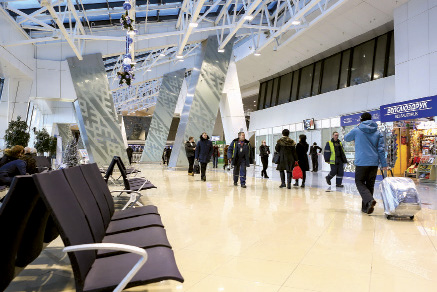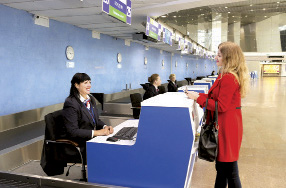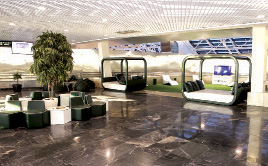
Lounges for air passengers have acquired contemporary features
When the once powerful Soviet Union collapsed, sovereign Belarus had to develop its own air transport from scratch. Intended to receive and depart planes every 2 minutes, the airport became empty. Its dark Soviet pompousness, limited passenger traffic and sparse services started to become depressing.
Today, the situation is different. Having visited just after reconstruction, I was agreeably surprised. It seems that only the old walls remain; the interior is filled with blue light, silent escalators and panoramic lifts. Each corner, despite the scale of the premises, looks inviting, served by modern systems of heating, ventilation and noise suppression. Judging by the number of those taking photos inside, people are pleased by the changes.
 However, the updated interiors are only the tip of the ‘iceberg’, notes Dmitry Melikyan, the Director General of the airport. About Br720 billion has been invested in reconstructing the air terminal, so that it rivals any in Europe. Passengers are assured convenience and security, including facilities for those with limited mobility; there are four panoramic lifts, while public washrooms have better access and wide cubicles. Meanwhile, ambulifts can bring a wheelchair aboard, bypassing the boarding bridge.
However, the updated interiors are only the tip of the ‘iceberg’, notes Dmitry Melikyan, the Director General of the airport. About Br720 billion has been invested in reconstructing the air terminal, so that it rivals any in Europe. Passengers are assured convenience and security, including facilities for those with limited mobility; there are four panoramic lifts, while public washrooms have better access and wide cubicles. Meanwhile, ambulifts can bring a wheelchair aboard, bypassing the boarding bridge.
Ten sleep-cabins have been installed in the transit lounge, costing just Br100,000 (about $7) per hour. Each includes toiletries and the administrator has knowledge of foreign languages.
Border control booths have been increased in number 2.5-fold, reducing queues; meanwhile, it takes just 30 seconds to process documents, against a ‘norm’ of two minutes. The same concerns customs inspection, as an automatic system scans luggage. Where suspicious objects or substances are detected, passengers are then asked to submit to personal inspection. In addition, the new, automated baggage-handling system can process up to 3,600 pieces of luggage per hour, automatically sorting by flight, with five levels of safety. Experts can monitor luggage from the moment of checking-in to loading onto the plane, so that loss and damage are almost excluded.
 Every aspect of passenger comfort has been considered, including Wi-Fi and copies of Belarusian newspapers (which prove very popular). You can recharge your mobile phone, download electronic books, book a hotel room or transport, hire a car, or organise an excursion. You can even have clothes repaired or have a haircut!
Every aspect of passenger comfort has been considered, including Wi-Fi and copies of Belarusian newspapers (which prove very popular). You can recharge your mobile phone, download electronic books, book a hotel room or transport, hire a car, or organise an excursion. You can even have clothes repaired or have a haircut!
It’s pleasing to see so many people using the airport: the volume of passenger traffic is growing annually, having reached 2.6 million people in 2014 — up 500,000 on 2013 (and set to rise by the same amount annually over the coming decade). Thanks to reconstruction, the airport can now handle up to 5.8 million passengers a year: a number to which Minsk Airport now aspires.
I watch three people taking photos: a mother from Gomel is seeing off her daughter and her French friend, to Barcelona. They are impressed by the inside of the airport, the young Frenchman smiling enthusiastically and gesticulating while the mother adds that he’s been delighted by everything in Belarus, and is fascinated by its calmness and hospitality. Against the tragic events in Paris, it’s quite understandable — but that’s another story.
By Vladimir Nikolaichuk











